Lenovo Yoga 3 Pro Review: Refreshed With Faster Core M
by Brett Howse on March 13, 2015 8:00 AM ESTGPU Performance
The Core M processor has a similar GPU to the new Broadwell-U series. The Core M-5Y71 has the HD 5300 GPU, which has 24 EUs (up from 20 on Haswell-U HD 4400) and has a clock speed of 300-900 MHz. This is actually the same number of EUs and frequency as the i5-5200U that we tested in the XPS 13, but of course in a 4.5 watt TDP rather than 15 watts like Broadwell-U. We have already seen that CPU performance is very good on Core M, but GPUs can draw quite a bit of power when pushed to the limit, so we will see how it compares. First up, we can take a look at performance in some synthetic benchmarks starting with Futuremark’s 3DMark.



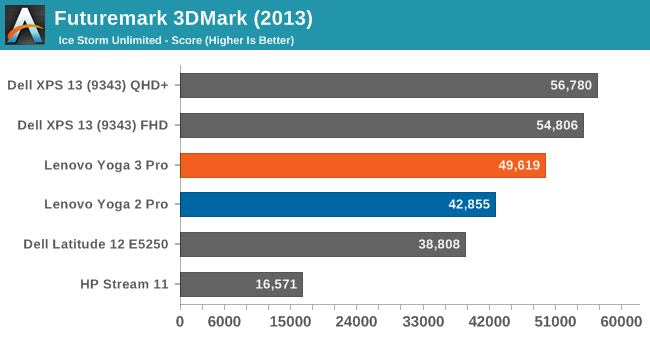
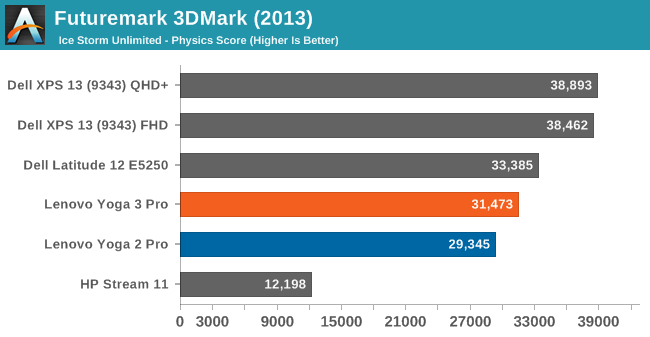
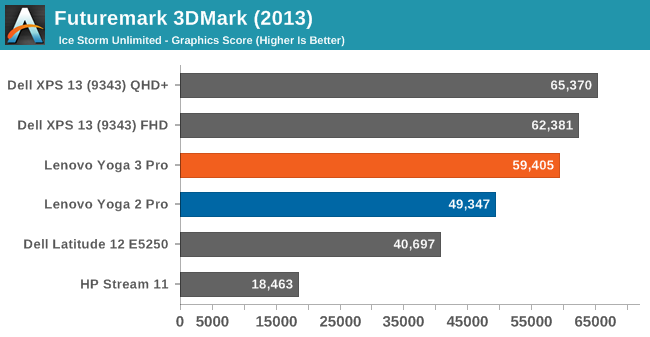
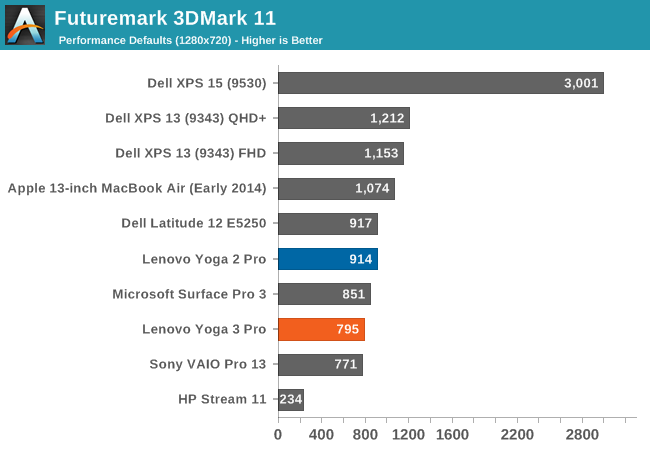
Unlike the CPU, the GPU runs out of headroom much quicker. On any of the sustained benchmarks, the Yoga 3 Pro scores significantly down on both the Haswell-U and Broadwell-U GPUs. Ice Storm Unlimited is the outlier, since it is such a short benchmark. The Core M does improve on Haswell-U in this benchmark. However compared to the HP Stream 11 which has the Atom 5 watt processor, Core M is way ahead here. Intel will be releasing a new Atom this year, and it really cannot come soon enough. Silvermont was a big improvement for Atom, but it is way behind Core M in terms of performance.
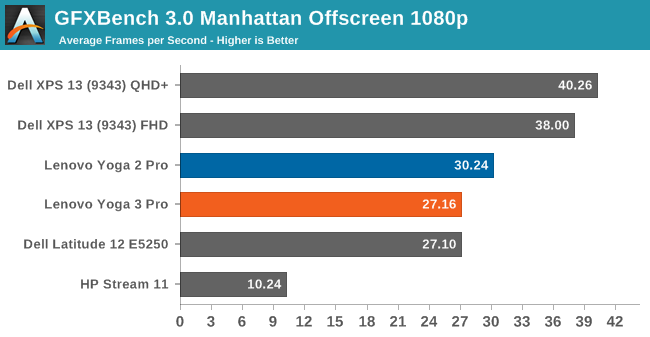

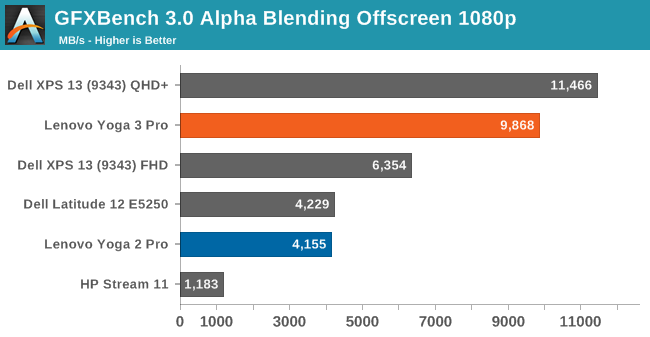
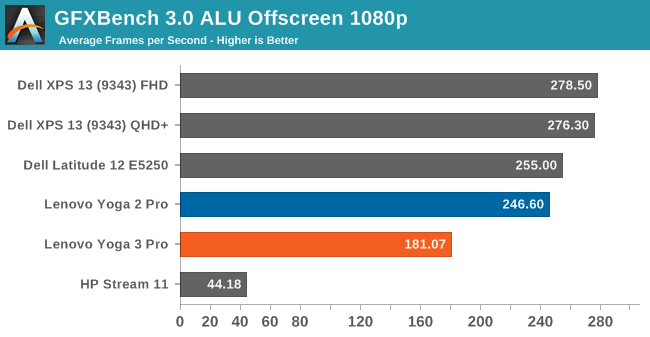

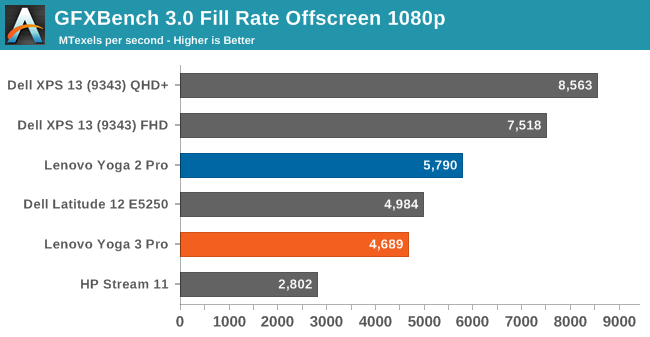

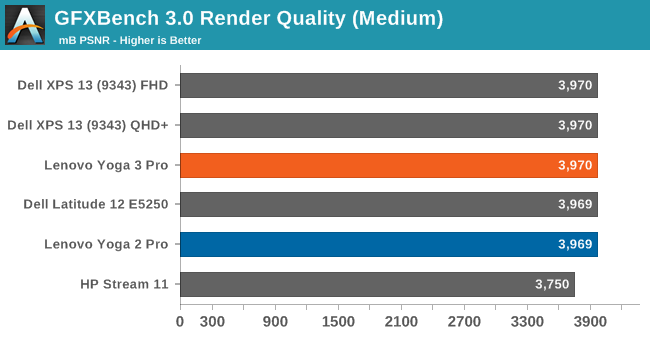
On GFXBench, we see a similar story. The 4.5 watt envelope for Core M restricts the GPU performance quite a bit, and it falls behind all of the other devices except Atom, where it destroys it. The exceptions are Driver Overhead and Alpha Blending, where newer drivers and the architectural changes of the Gen 8 graphics allow the Yoga 3 Pro to pull ahead of the Yoga 2 Pro.

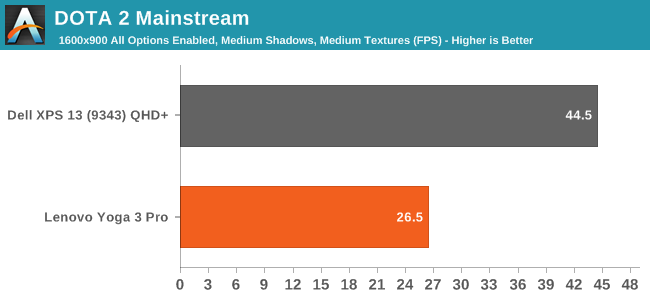
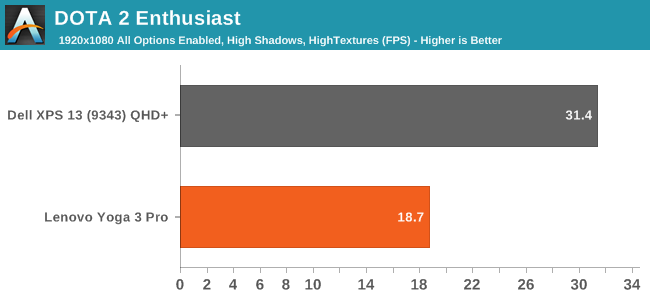
Our final GPU benchmark for Ultrabooks is our new Dota 2 Bench. We only have a single comparison at this point. The Dell XPS 13 has Broadwell-U with HD 5500 graphics. Even though both have the same number of EUs and frequencies available, it is clear the 15 watt part has a lot more headroom to allow the GPU to keep the frequency up. On Dota 2, the Yoga 3 Pro is really only playable on the Value settings, whereas the XPS 13 is over 30 FPS even on the Enthusiast settings.
For the CPU performance, Core M shows that it has the legs to compete against Haswell-U, but on the GPU side of the fence it is a different story. Core M hits the TDP limit much quicker and performance takes a nose dive. Intel still has quite a bit of work left to do on the GPU side.
Even though this is not a pure tablet, it can be used in tablet mode, so we can compare it to those devices as well.
Tablet Comparison
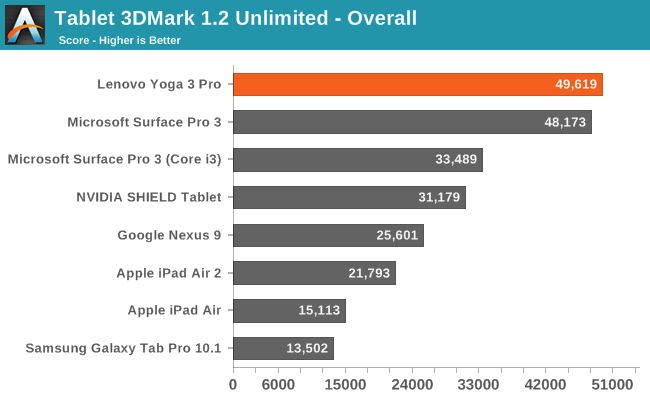
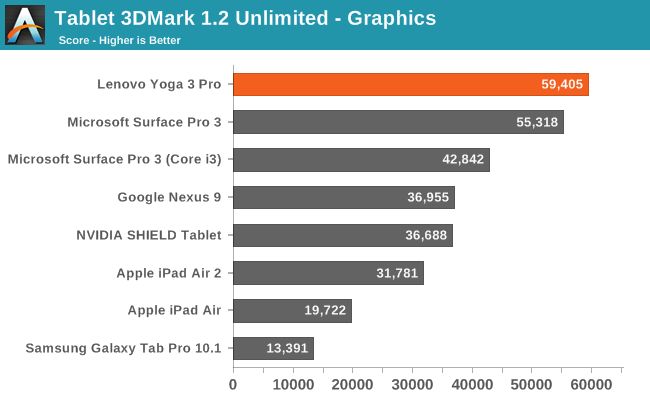

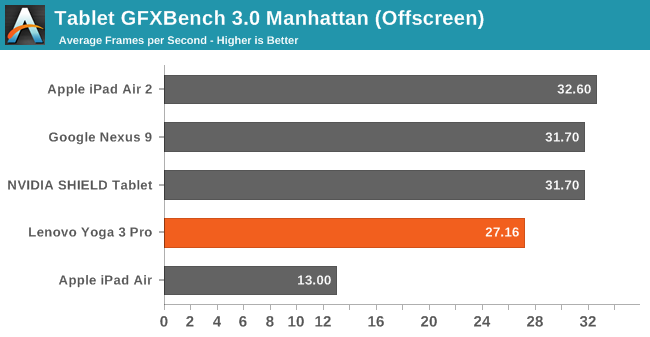

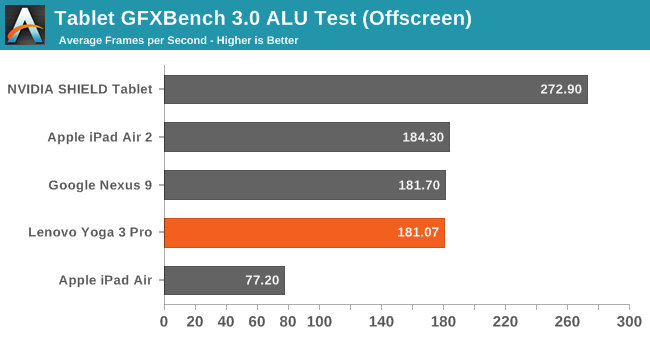
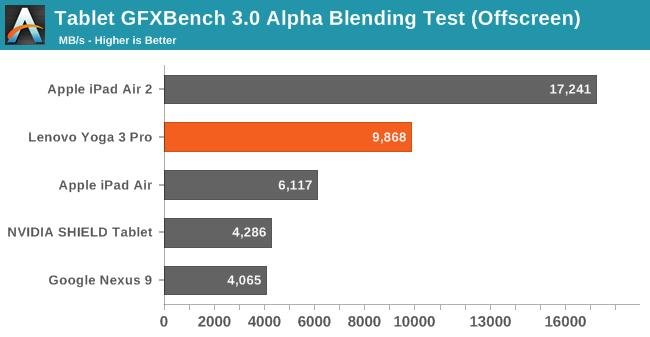

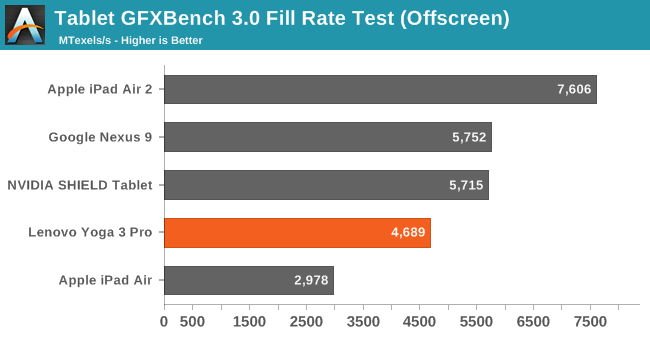
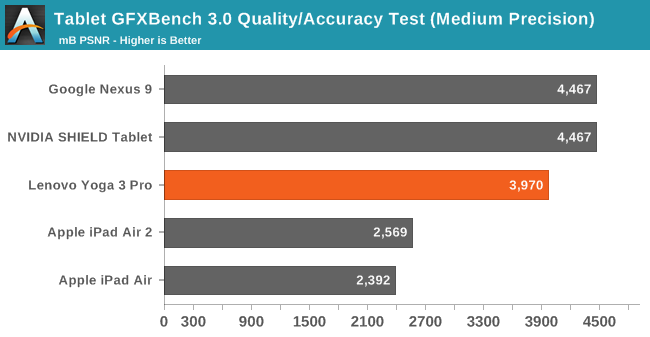
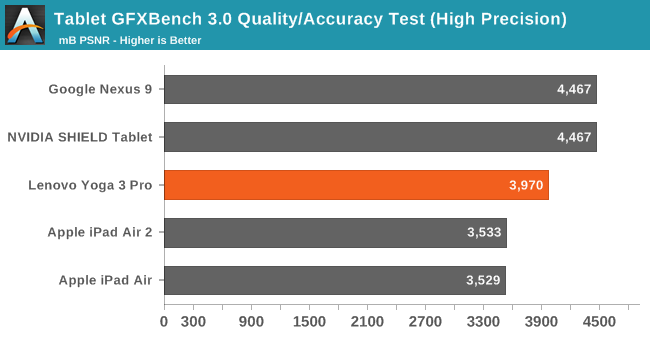
The typical tablet SoC will be very similar to the Core M processor as far as TDP. Though none of the tablets will advertise TDP, under load it is going to be fairly close to 5 watts or so. Some of the higher performance tablets may even pull a bit more power. We see some different results looking at the different benchmarks. 3DMark is very much a win for Core M’s GPU, but the benchmark is very short. It shows the potential for the HD 5300, but on any sustained workloads it bumps into the TDP fairly quickly and the scores go down.
Of note from the 3DMarks scores though is the Physics score, which is a CPU score. Core M has quite a jump in performance compared to the average Tablet SoC. This also is obvious when you compare the web tests between the Core M and a tablet. For instance, the Apple iPad Air 2 scores 4014.3 in Kraken, and the Yoga 3 Pro scores 1729.7 (lower is better – it is a score in milliseconds). WebXPRT is 1728 on the Yoga 3 Pro, but the iPad Air 2 only scores 688 (higher is better) and A8X has three CPUs versus two in Core M. Apple has been touted as having one of the best SoC CPUs, but they are no match for Intel in this arena.
The GPU side is not as rosy though, with the GFXBench scores placing HD 5300 well behind the top tablet GPUs of today. The performance potential is there for HD 5300, but it needs more TDP to exploit it with the current architecture. This is an area where Intel has been upgrading every single year, but the GPU being integrated into the CPU means that GPU updates have to wait for new product launches.










113 Comments
View All Comments
name99 - Friday, March 13, 2015 - link
Good luck with that. Intel puts more care into the design of the glue those stickers use than practically anything else they ship.After you do finally manage to pull the sticker off, you're left with a nasty glob of gunk on your machine, and it's not clear quite what will remove it while not hurting the finish of the machine. Acetone? Alcohol? Vinegar?
fokka - Friday, March 13, 2015 - link
try baby oil. i agree though, those pesky stickers should simply use the glue they use on post-its, that would be nice for a change. or, you know, get rid of those useless things all together.jabber - Saturday, March 14, 2015 - link
Actually I've found gently prising them off slowly lifts most of the glue with the sticker, especially when they are new. Then use the sticker to dab over any glue left gets 99% of it. Not difficult.mkozakewich - Saturday, March 14, 2015 - link
Oils destabilize rubbers. Try accidentally leaving a bit of turkey stock in the rubber part of a baster, or try eating peanuts while chewing gum.Alexvrb - Sunday, March 15, 2015 - link
I would probably use Goo Gone, if I was prone to caring about removing factory stickers.Manch - Sunday, March 15, 2015 - link
wd40. put a spot on a rag and wipe. then clean with alcohol.limitedaccess - Friday, March 13, 2015 - link
Can verify that it is actually 4.5w TDP and not set for 3.5cTDP? The original was version was found to use the lower cTDP setting which is why performance was low (especially in gaming).Was the performance actually sustainable? For instance the SP3 i3 did not show performance regression in gaming benchmarks until after the first pass of Dota 2.
I'm also wondering whether or not mobile reviews from now on should start looking into sustained performance and perhaps monitoring what clock rates actually are when in use.
What were the temperatures?
limitedaccess - Friday, March 13, 2015 - link
Just to add in general I'm wondering in mobile reviews are they actually being down to account for performance differences under extended use?We now see the market move towards more variable and burst based performance I think this does need to be looked at more. A 10 minute gaming benchmark for instance may not represent an actual extended game play session if this isn't accounted for.
Brett Howse - Friday, March 13, 2015 - link
CPU Z shows it as a 4.5w part, and the clock speeds agree. I actually was hoping it would be cTDP up to 6w since it has a fan but it does not appear to be.Sustained performance did not appear to be a big factor. I ran Cinebench R15 six times in a row (which took about an hour total) and all of the scores were within a fraction of a percentage of each other.
fokka - Friday, March 13, 2015 - link
i think a cTDP of 6w would be a better fit for an actively cooled 13-inch machine, hell, i could even get behind a cTDP of 10 watts. the gap between 4.5 and 15w just seems so big otherwise. but with power states and turbo clocks diluting the whole TDP-game anyways, i don't even know what i want in a cpu anymore. o.O